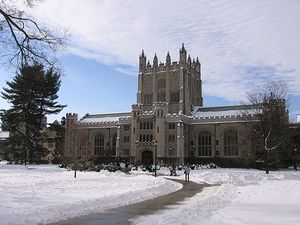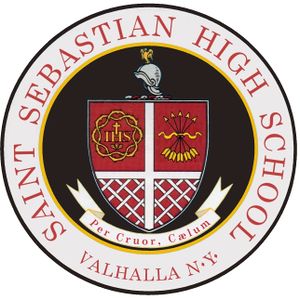St. Sebastian High School
History
The academy was founded by an unlikely pair: Brother Samuel Bartleby, Jesuit scholar, and Elliot Hurst, scion of old money and titled privilege, scoundrel by nature. (There are no reliable records to substantiate Mount Pleasant Historical Society’s pet rumor that a fair number of area residents can most likely trace their lineage back to this common ancestor.)
Hurst’s relationship with his socially and politically prominent family, particularly his father, was combustible at best. His adolescent rebellion became a notorious lifestyle as he entered young adulthood. He was asked to leave every academy he attended throughout New England until entering King’s College (now Columbia University) in 1758, shortly after the university received its Royal Charter from King George II. Though it had been established by the Church of England, the young scholar Bartleby had taken a sabbatical to do research at the new institution.
It remains a mystery as to how the two met, though most agree that it was during a debate which left Hurst speechless. Impressed with the black-robed scholar’s persistence and wit, he latched onto the Jesuit with avid curiosity.
Although the rogue was often conspicuously absent from Sunday services, he became steadfastly devoted to his religious friend. Bartleby was the only person he seemed to respect, and the brother became his mentor and confidant.
When his father died in Hurst’s final year at the university, he seemed to experience a crisis of faith and conscience. He left the school and returned to the family estate located in what is now Mount Pleasant, accompanied by Brother Bartleby. Acting on what some called a “wild delusion brought about by guilt and grief,” Hurst secured the rights to the land surrounding the ancient Library of Saint Catherine (which he dubbed “St. Kate’s”), and established the Academy of Saint Sebastian.
The first instructors were Jesuits from Bartleby’s order, and Hurst endorsed a rigorous curriculum and a moral code of the highest order. A skilled and avid writer himself, he cherished literary pursuits above all others. He and Bartleby added entire wings to St. Kate’s through their diligent research and acquisitions from around the world.
The only thing which drew Hurst’s attention from his scholastic fixation was Mary Lunette Kincade. She captured his heart and became, as he wrote, his “mate, match and inspiration.” They married and had three children together, though two died in infancy and the youngest in childbirth. He remained a faithful husband, and admitted only to his private journal that regretted the fact that he would never know whether he’d have been a better father than his own was to him.
After his wife’s death Hurst became reclusive but remained a zealous advocate of what he termed “the freedom of knowledge,” encouraging students to never fear the truth, and seek it with faith and love.
Hurst was laid to rest alongside his wife and children in a plain stone crypt in the Cemetery of the Archangels commissioned by Bartleby to honor his lifelong friend and student.
Today
The academy (co-ed since 1940) is known as St. Sebastian Elementary and St. Sebastian High School. The two institutions are only nominally associated with one another, sharing a campus divided by St. Catherine’s Library.
The curriculum focuses on liberal arts and the classics (including Latin and Greek), and offers over a dozen Advanced Placement classes. All students take special courses to hone their writing skills. The student:teacher ratio is 7:1, and over half the faculty hold graduate degrees. The average class size is 11.
The Bastian has a competitive athletic program with 9 varsity sports and 20 teams in total. Varsity boy's baseball and ice hockey, girl's field hockey and co-ed track teams routinely win championships and have produced a record number of professional athletes.
The school colors are red and black.
The Yearbook, The Arrow, is published each year in May, and the Literary Magazine, The Dart, comes out each semester.
The uniform for grades 9-12 (available for purchase through the school):
- Boys: black pleated slacks, white Oxford shirt, black school blazer with crest, navy blue stripe (underclassmen) or crimson stripe (upperclassmen) tie, white or navy blue socks and dress shoes. In May, juniors choose the tie their class will wear as seniors the following year, navy blue or crimson with a unique design.
- Girls: pleated plaid skirt (grey/navy blue/crimson) with hem one inch below the knee, white Oxford shirt, black school blazer with crest, navy blue stripe (underclassmen) or crimson stripe (upperclassmen) tie, navy blue knee socks, dress shoes with heels no higher than one inch. In May, juniors choose the tie their class will wear as seniors the following year, navy blue or crimson with a unique design.

